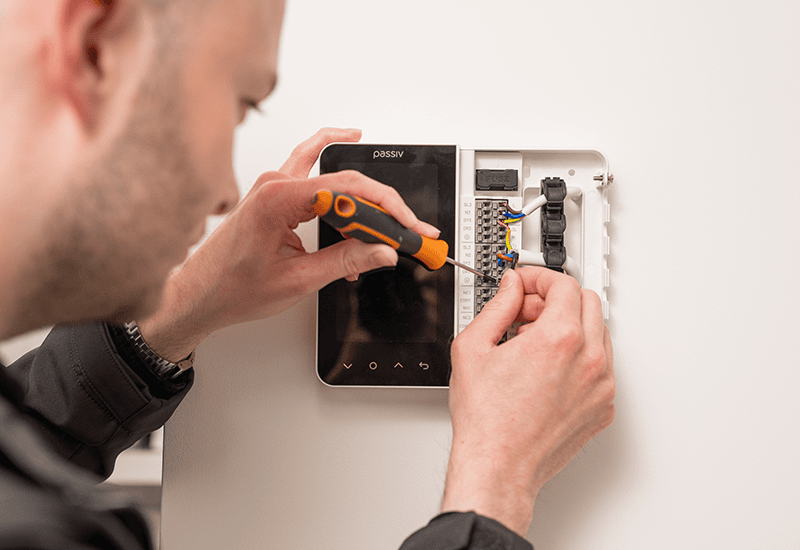So far in our series looking at why heat pumps need smarter control, we have explored how the latest generation of controls can improve a heat pump’s efficiency and make keeping warm and comfortable easy. In part three, we’ll look at how ‘time of use’ electricity tariffs can make heat pumps even cheaper to run by consuming electricity at times of the day when prices are lower.
In the first Insight of this series, we looked at how the efficiency of a heat pump (its Coefficient of Performance, or COP) impacts heating bills. A higher COP means a heat pump is running more efficiently, consuming less electricity and therefore costing less to run. At current electricity prices, a heat pump with a COP of 3.5 in the average UK home will cost £1,314 a year. The Passiv Smart Thermostat can improve the efficiency of a heat pump by 17%, reducing this bill significantly. Check out Why heat pumps need smarter control – improving efficiency to understand why.
The amount of electricity that a heat pump consumes is just one factor that affects your heating bill. In the last few years, ‘time of use’ tariffs where the price you pay for electricity varies throughout the day have become increasingly popular. These tariffs are great if you can alter when you use electricity to take advantage of ‘off-peak’ periods when prices are cheaper. So, if you have a heat pump and are on a time of use tariff, your heating bill is determined by how much electricity you use and when you use it.
Time of use tariffs exist because of the varying cost of generating and supplying electricity at different times. In the UK, electricity prices change on a half-hourly basis. There are many complex factors that influence these prices, but fundamentally they are driven by supply and demand. If supply is high and demand is low, prices will be low. If supply is low and demand is high, prices will be high. For electricity, demand is determined by the amount of power being consumed by homes and businesses. Supply is impacted by many things including what power stations are available to generate electricity and, in the case of renewables, what the weather is like. In general, this means that UK electricity prices are highest in the early evening and lowest overnight.
Most homes in the UK are on a flat electricity tariff where the price paid is the same, regardless of when electricity is consumed. This doesn’t mean the cost of the electricity being consumed is the same every half-hour, just that the energy supplier is managing the exposure to those variable costs and is instead charging a single, simple rate to their customers. Time of use tariffs are different as they expose homeowners to some or all of that half-hourly variability in pricing.
Time of use tariffs aren’t new. In fact, they first became popular in the 1960s with the arrival of the ‘Economy 7’ tariff. As the name suggests, Economy 7 tariffs provide seven hours of cheaper electricity overnight. They were introduced to encourage people to shift their consumption to the night at a time when nuclear power was becoming a more important part of the UK’s electricity mix. Nuclear power stations cannot easily fluctuate their output, so it became vital to flatten the UK’s daily electricity demand to avoid too much power being generated overnight. Economy 7 is still popular today and is by far the most common time of use tariff in the UK, with around 2.5 million households using them.
In recent years, many more time of use tariffs have become available as a result of smart meters which can accurately measure how much electricity your home uses. Some of these tariffs are much more complex, with multiple rates a day or even prices that vary every single half-hour. Octopus Energy has been at the forefront of the development of these tariffs. The Octopus Cosy tariff is a time of use tariff designed for heat pumps that offers three rates across multiple time periods each day. The Octopus Agile tariff has prices that change every single half hour and are only published a day in advance.
Time of use tariffs can offer great savings if you have a large and flexible electricity demand. Electric vehicles work particularly well with Economy 7 tariffs because for most people it is really convenient to charge up with cheap electricity overnight when the car is sitting idle on a driveway.
Time of use tariffs may also suit heat pumps, which can easily double the electricity demand of the average home. The challenge with heat pumps is that when you want to be warm and have hot water generally coincides with when electricity prices are high. That is, on dark, cold winter evenings. But heat pumps, if operated correctly, can be very flexible. A home is a bit like a battery – if you preheat it, it will stay warm for some time. The same is also true of a hot water tank. This means that to some extent, you can run your heat pump when electricity prices are low and turn it off when they are high.
For simple time of use tariffs, it might be possible to do this by adjusting your schedule. If you are on an Economy 7 tariff, perhaps you just turn your heat pump on a few hours earlier in the morning. But for complex tariffs like Octopus Cosy or Agile, it becomes much more difficult. Preheating probably means running a heat pump at a time when you don’t want to be warm and that means consuming more electricity than you need to. So when should you start the heat pump, how much should you preheat by and how much comfort should you be willing to sacrifice to get the best savings?
It’s here that the latest generation of smarter heating controls, like the Passiv Smart Thermostat, come into their own.
The Passiv Smart Thermostat can optimise a heat pump to a variety of time of use tariffs, including complex ones like Octopus Cosy and Agile. It makes this simple to do. There is no need to adjust your schedule to try to make the most of low-priced periods. Instead, just set your usual schedule in the Passiv app or Programmer and then select your time of use tariff in the app. The Passiv Smart Thermostat will take care of the rest, automatically optimising your heat pump to reduce your heating bill while maintaining your home comfort. Crucially, it will consider the complex trade-off between consuming a greater amount of lower-cost electricity in a less efficient way (either because the outside temperature means the heat pump will be running with a lower COP or because significant preheating is required) versus consuming less, more expensive electricity in a more efficient way.
The technology that the Passiv Smart Thermostat uses to optimise to time of use tariffs is the same that is used to optimise the flow temperature and increase the COP of a heat pump by 17%. That means heating bills are reduced because the heat pump is running more efficiently and because it is consuming low-priced electricity at the same time. The Passiv Smart Thermostat can reduce a heating bill by a further 10% by optimising to a time of use tariff.
By the way, did we mention that this is included for free? That’s right, once you purchase the Passiv Smart Thermostat all its features are provided for free!
These new heat pump controls are starting to sound really smart, saving you money not only by making a heat pump more efficient but also by taking advantage of time of use electricity tariffs. But if a heat pump can be flexible when your electricity prices change throughout the day, can this flexibility save you money in other ways? Stay tuned for the next in our series of ‘why heat pumps need smarter control’ where we’ll explore the exciting world of Demand Side Response or DSR, where homeowners can get paid for using less electricity at certain times!



